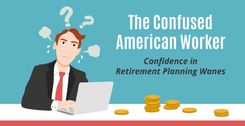Related Posts
Employers and Organizations
5 Steps to Get Your Employees Ready for Retirement
Last Update: December 11, 2018
As an organization, you have young employees barely thinking about retirement to employees nearing retirement and everything in between. Additionally, you have employees that are financially prepared, those working towards that goal, and still others that show no outward signs of concern. How can you adequately prepare these groups for retirement and avoid the problems that occur when employees are not on track?
The answer is targeted solutions, as well as best practice strategies. Here are five that will help your organization prepare employees for retirement.
Step 1: Communication
The first step in creating retirement readiness is communication. However, not all communication about retirement is beneficial. One-size-fits-all messages are typically ignored because they really don’t “fit” anyone at all. That’s why it is important to customize the messages you send so that they are impactful. To do this, they should be personalized and have an action component.
Here are some other things to keep in mind about communication:
- The language should be easy to comprehend. Avoid using jargon.
- Communication should be received regularly.
- Information should begin immediately rather than waiting close to retirement age.
- The results of the communication should be measurable, so that you, as an organization, can determine its effectiveness.
To be focused, you first need to determine the needs of your employees. This can be done by looking at an employee’s work stage (new-hire, mid-career, etc.), demographics (gender, age, income, etc), attitudes (optimistic, risk-tolerant, cost-conscious, etc), how they wish to get communication (face-to-face, social, tech, etc.), or any other grouping relevant to your organization.
Next, you will need to look at your plan’s characteristics and find messages that relate to these specific groups you’ve identified. The communication should address specific concerns you know this group has, explain how retirement savings is beneficial, and then provide solutions based on the plan offered.
There are many different channels for the delivery of communications. Some of these include:
- Newsletter
- Videos
- Apps
- Personalized statements
Try using a variety of methods since different employees will respond to different types of messages.
Finally, do not rely on “canned” messages from the contribution plan. These are good sources of supplemental material, but they are typically very generic and are not consistent. They also are not segmented based on your organization’s needs. And, more often than not, your employees will see them as advertisements rather than useful information.
Step 2: Financial Wellness Education
The communications you send can often help educate your employees about retirement and why saving for this event is so important. However, simple communications will not meet the educational needs of your employees.
According to the 2017 PWC Employee Financial Wellness Survey1, there is a lack of understanding when it comes to retirement planning:
- 25% of employees are not saving for retirement
- Almost half of current retirement-age employees cannot afford to retire
- 40% of employees have less than $50,000 in a retirement account
These numbers indicate that employees need access to education. But not all financial and retirement education are created equally. The right education plans take the following things into account:
- There are many different retirement vehicles an employee can use
- Tax considerations vary depending on employee circumstances
- Employees have different awareness levels concerning retirement
- Retirement requires employees to make and keep long-term goals
Enrich offers a “Planning For Retirement” course that provides actionable information to employees. Employees taking this course will understand retirement account, tax implications, pitfalls, the impact of saving now, social security, and more. We even offer a Retirement Analyzer Tool that helps employees learn what they need to do to bridge the gap between their retirement needs and their current savings. To find out more about how Enrich’s Financial Wellness tools can benefit your organization, you can watch our demo video here.
Step 3: Provide Automation
In general, humans tend to do nothing unless prompted. That’s why you might consider offering automated ways to help your employees. These include such things as:
- Auto-enrollment
- Auto-escalate
- Target-date funds
- Default investment alternatives
This will help your employees save the right amount and in the right way, even if they don’t actively choose to do so.
Does automation work? Here are some statistics2:
- Auto-enrollment increases plan participation from 70% to 80%
- Auto-escalate increases participation to 81%
Keep in mind that automation is not the right path for everyone. Employees are individuals, and most automated savings are one-size-fits-all type programs. That’s why employees need education to help them determine if they are saving the right amount for their current needs and financial wellness.
Step 4: Employer Matching
The Inside America’s Retirement Plans Survey above also revealed that employer matched contributions helped increase plan participation. In fact, when using both automation and matching, participation increases from 70% to 83%.
Of course, there are many different types of employer matching formulas, and determining which formula to use with which employees can help increase plan participation. For instance, you may want to target mid-career employees and offer a chance to catch up their retirement savings. This can be done by increasing the employee deferral and/or providing a larger profit-sharing contribution.
Step 5: Providing Retirement Income
Finally, as your employees get closer to retirement, they need to learn how to change their retirement savings into income. As an organization, your plan can help by offering such things as lifetime annuities or qualifying longevity annuity contracts (QLACs). The educational component of your plan can also help retirees see the different spend-down approaches that will help employees from running out of money.
Although there is no way to ensure that every employee will be ready for retirement, by following these five steps, you will help the majority be in a good position for retirement. Additionally, employees will be happier, more loyal, and more productive when not worried about their finances and retirement. If you are interested in making the Enrich Financial Wellness platform available to your organization, you can request a product demo here.
Featured Posts

Employers and Organizations
3 MIN
10 Simple Ways Benefits Managers Can Recession-Proof Their Employee Benefits Package

Employers and Organizations
3 MIN
3 Reasons to Make After-Tax Contributions to Your Retirement Plan

Employers and Organizations
4 MIN
Financial Information vs Employee Behavior Change: Which Is More Important for Your Company’s Financial Wellness Program?

Employers and Organizations
3 MIN
Does Your Employee Financial Wellness Program Take Mindset Into Consideration?
Related Posts

Employers and Organizations
3 MIN
1 in 3 Americans Plan to Delay Retirement – 10 Tested Ways a Director of Retirement Can Help Get Them Back on Track

Enrich News
2 MIN
Empower Employees to Prepare for Retirement with New Course

Enrich News
3 MIN
The Confused American Worker
